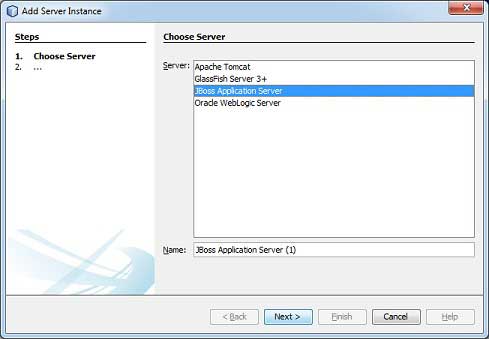EJB is a framework for Java, so the very first requirement is to have JDK installed in your machine.
System Requirement
| JDK | 1.5 or above. |
|---|
| Memory | no minimum requirement. |
|---|
| Disk Space | no minimum requirement. |
|---|
| Operating System | no minimum requirement. |
|---|
Step 1 - verify Java installation in your machine
Now open console and execute the following
java command.
| OS | Task | Command |
|---|
| Windows | Open Command Console | c:\> java -version |
| Linux | Open Command Terminal | $ java -version |
| Mac | Open Terminal | machine:~ joseph$ java -version |
Let's verify the output for all the operating systems:
| OS | Output |
|---|
| Windows |
java version "1.6.0_21"
Java(TM) SE Runtime Environment (build 1.6.0_21-b11)
Java HotSpot(TM) 64-Bit Server VM (build 23.21-b01, mixed mode)
|
| Linux |
java version "1.6.0_21"
Java(TM) SE Runtime Environment (build 1.6.0_21-b11)
Java HotSpot(TM) 64-Bit Server VM (build 23.21-b01, mixed mode)
|
| Mac |
java version "1.6.0_21"
Java(TM) SE Runtime Environment (build 1.6.0_21-b11)
Java HotSpot(TM) 64-Bit Server VM (build 23.21-b01, mixed mode)
|
If you do not have Java installed, install the Java Software Development Kit (SDK) from
http://www.oracle.com/technetwork/java/javase/downloads/index.html. We are assuming Java 1.6.0_21 as installed version for this tutorial.
Step 2: Set JAVA environment
Set the
JAVA_HOME environment variable to point to the base directory location where Java is installed on your machine. For example
| OS | Output |
|---|
| Windows | Set the environment variable JAVA_HOME to C:\Program Files\Java\jdk1.6.0_21 |
| Linux | export JAVA_HOME=/usr/local/java-current |
| Mac | export JAVA_HOME=/Library/Java/Home |
Append Java compiler location to System Path.
| OS | Output |
|---|
| Windows | Append the string ;C:\Program Files\Java\jdk1.6.0_21\bin to the end of the system variable, Path. |
| Linux | export PATH=$PATH:$JAVA_HOME/bin/ |
| Mac | not required |
Verify Java Installation using
java -version command explained above.
Step 3: Download and Install NetBeans IDE
Download latest version of NetBeans IDE from
https://netbeans.org/downloads/index.html. At the time of writing this tutorial, I downloaded
Netbeans 7.3 which comes bundled with JDK 1.7. using following link
http://www.oracle.com/technetwork/java/javase/downloads/index.html
| OS | Installer name |
|---|
| Windows | Netbeans 7.3 |
| Linux | Netbeans 7.3 |
| Mac | Netbeans 7.3 |
Step 4: Setup JBoss Application Server:
You can download the latest version of JBoss Server from
http://www.jboss.org/jbossas/downloads/. Download the archive as per the platform. Extract the Jboss to any location on your machine.
| OS | File name |
|---|
| Windows | jboss-5.1.0.GA-jdk6.zip |
| Linux | jboss-5.1.0.GA-src.tar.gz |
| Mac | jboss-5.1.0.GA-src.tar.gz |
Step 5: Configure JEE Plugins to Netbeans
Open Plugin window using Tools > Plugins. Open "Available Plugin"
tab and select "Java EE Base" and "EJB and EAR" under "Java Web and EE"
category. Click install button. Netbeans will download and install the
respective plugins. Verify plugins installation using "Installed" tab.

Step 6: Configure JBoss Server in Netbeans
Go to Services tab and right click on servers to add a new server.

Add Server Instance wizard will open. Select JBoss and in next step enter the relevant details to configure server in netbeans.

Once everything is cofigured, you'll see the following screen.

Step 7: Install Database Server (PostGreSql)
Download latest version of PostGreSql database server from
http://www.postgresql.org/download/. At the time of writing this tutorial, I downloaded
PostGreSql 9.2
| OS | Installer name |
|---|
| Windows | PostGreSql 9.2 |
| Linux | PostGreSql 9.2 |
| Mac | PostGreSql 9.2 |

 Add Server Instance wizard will open. Select JBoss and in next step enter the relevant details to configure server in netbeans.
Add Server Instance wizard will open. Select JBoss and in next step enter the relevant details to configure server in netbeans.  Once everything is cofigured, you'll see the following screen.
Once everything is cofigured, you'll see the following screen.

 Add Server Instance wizard will open. Select JBoss and in next step enter the relevant details to configure server in netbeans.
Add Server Instance wizard will open. Select JBoss and in next step enter the relevant details to configure server in netbeans.  Once everything is cofigured, you'll see the following screen.
Once everything is cofigured, you'll see the following screen.

No comments:
Post a Comment